DeShone Kizer has been a bit of an enigma this year. At times, he has looked like a sure fire first round NFL draft pick, big, strong, athletic, confident, decisive, accurate. Other times he has been inconsistent, indecisive and struggled with accuracy. The ups and downs in his play are due to a variety of factors, including being the quarterback of a team that frankly isn’t that good. However, some of the problems Kizer has experienced this year are due to inconsistencies in his throwing mechanics. Let’s take a look at the film and I’ll show you what I mean.
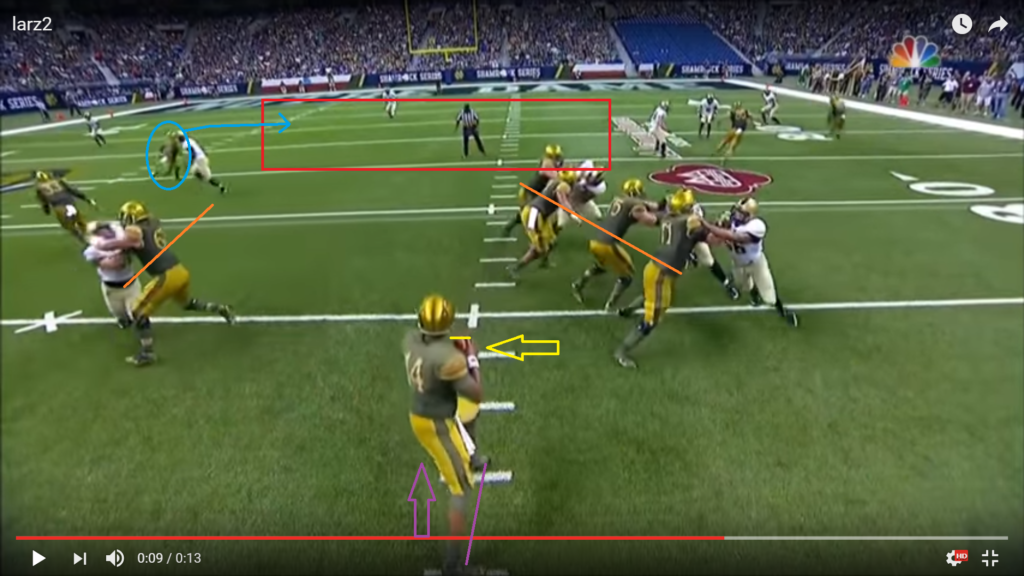
Late in the first half against Army. DeShone Kizer will try to hit CJ Sanders (blue circle) for a big gain. The pattern Sanders is running (blue arrow) will take him right into the middle of the field which is wide open (red rectangle). Kizer will benefit from outstanding pass protection (orange lines). The offensive line has opened up a huge throwing lane and is absolutely mauling the Army defenders. Oh and the game is being played in a dome, so weather won’t be a factor (I’m looking at you North Carolina). It really doesn’t get any easier than this for a quarterback.
At this point, Kizer has the ball in good position (yellow arrow). Pay special attention to how high he is holding the ball (yellow line); this will be important when we look at the next screen shot. Kizer’s footwork appears to be pretty good as well. He has planted his back foot and should now be shifting his weight forward (in the direction of the purple arrow) to start the throw. The only concern is that Kizer’s stance is pretty wide (purple line). If his stance stays this wide, it will make it difficult to effectively shift his weight.
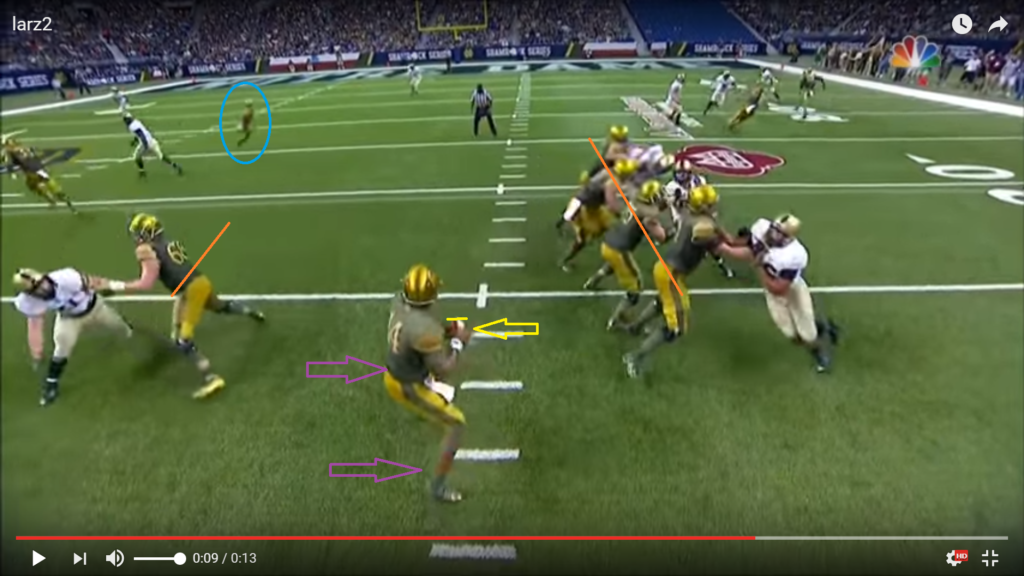
First of all, check out the offensive line (orange lines). It looks like they are working on a blocking sled, not going against actual defenders. That’s pretty impressive.
Unfortunately, this is where the problems begin for Kizer. His weight is still on his back hip and foot (purple arrows). CJ Sanders is wide open (blue circle), so Kizer should be moving his weight forward and initiating the throwing motion. For some reason he hesitates and lowers the ball slightly (yellow line and arrow), instead of moving it up and into throwing positon. While this isn’t the end of the world, the extra motion wastes time and makes a late throw even later.
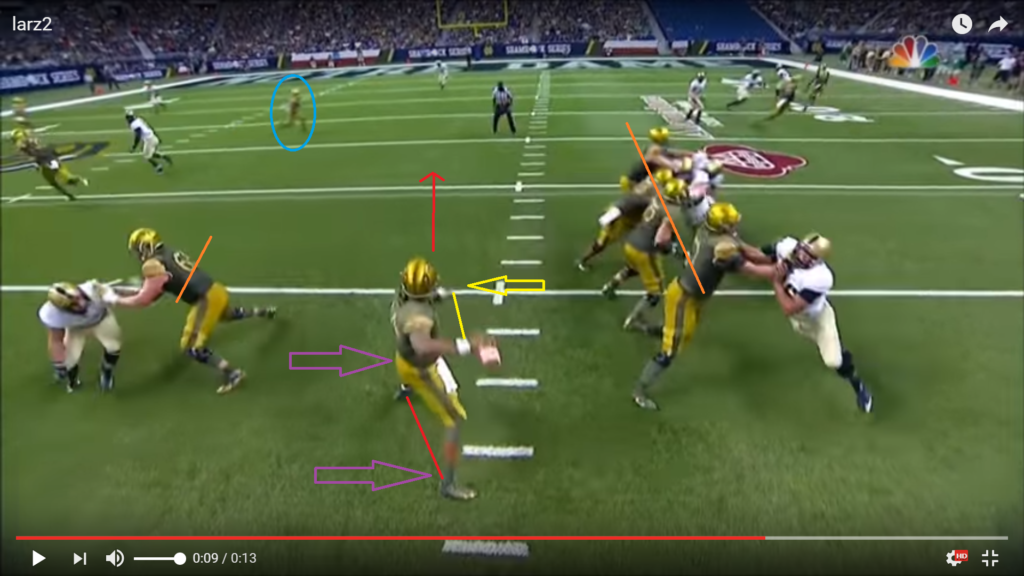
Kizer has now started the throwing motion; his lead arm has moved away from the ball and is rotating out of the way (yellow arrow). This is the correct motion; however, the lead elbow appears to be too far ahead of the ball (yellow line). If the lead elbow is too far ahead, the quarterback will be pulled off balance in the direction of the yellow arrow, instead of in the direction of the throw (red line). The likely reason that the lead arm is so far out in front is that Kizer knows he is late on the throw so he is rushing to catch up.
Kizer also continues to have problems with his weight distribution. His back hip and foot are still heavily weighted. By this time in the throwing motion, he should be moving his weight forward, toward the target (red arrow, blue circle). To make matters worse, Kizer stance is still pretty wide (red line), as previously mentioned this will impair his ability to shift his weight forward.
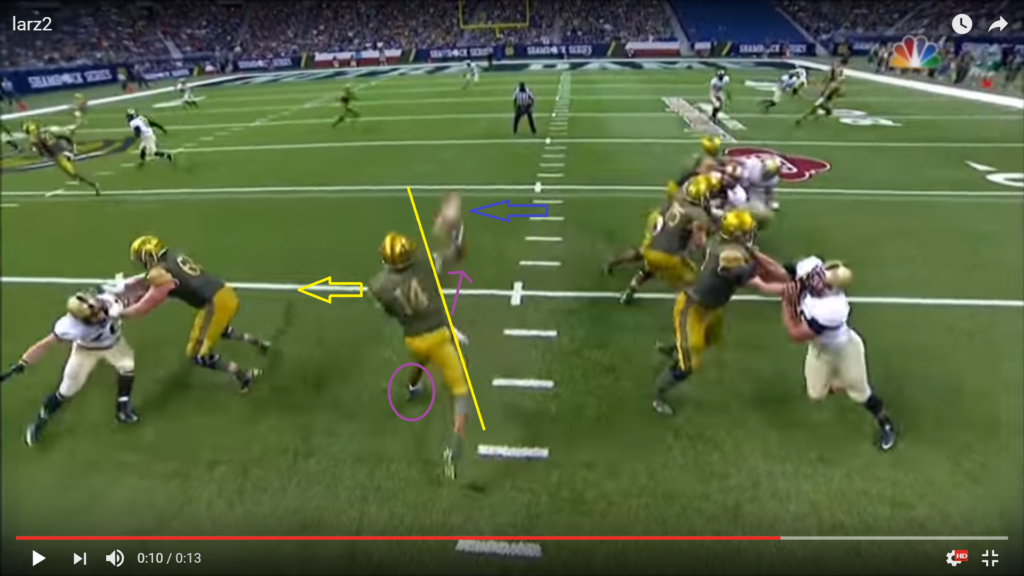
Kizer is about to release the football (blue arrow). His front foot is in good position, pointed to the target (purple circle). As well, his back hip has started to move towards the target (purple arrow) and his weight is finally moving forward. The only thing to be worried about at this point is how his body is tilted at an angle (yellow line), this isn’t exactly a solid, balanced throwing position and could cause problems.
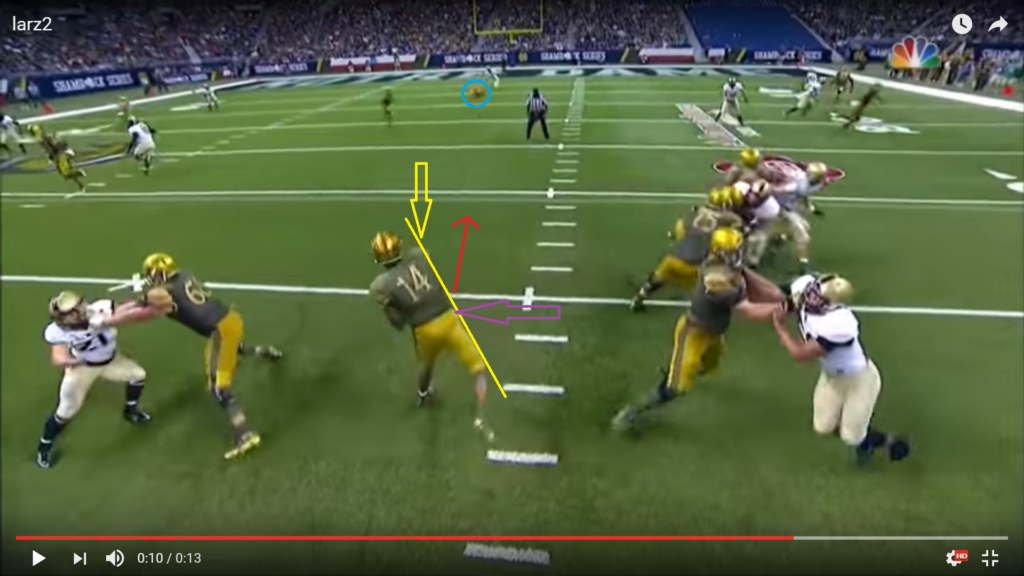
The ball is in the air (blue circle). The way the quarterback follows through after the ball is thrown can provide clues as to how the pass will end up. In this case, the follow through suggests there might be some problems with the throw.
The first thing that jumps out is that Kizer still appears to be tilting to the side (yellow line). At this point he should be more upright and his body should be moving more towards the target (red line). The primary reason for this unbalanced follow through is his shoulders are out of sync with his hips. While the shoulders should be ahead of the hips in the throwing motion, you can see that Kizer’s back shoulder (yellow arrow) is too far ahead of his back hip (purple arrow). This is pulling him into an unbalanced position which makes it more difficult to throw accurately.
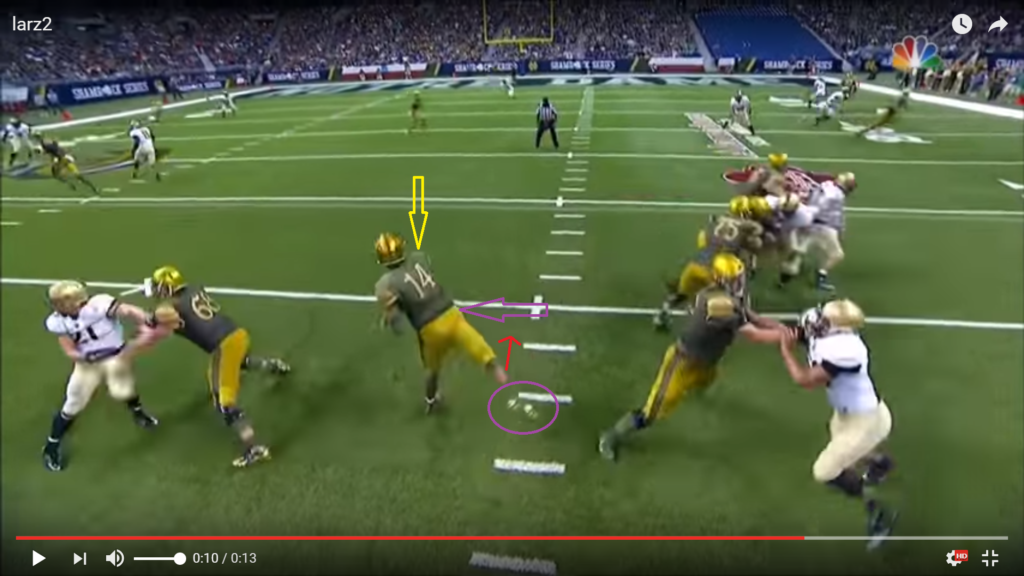
A fraction of a second later and you can see that Kizer is even more out of sync. His back shoulder (yellow arrow) is way ahead of his back hip (purple arrow). To compensate, he has to kick his back leg out to the side (purple circle). At this point his back leg should still be moving towards the target (red arrow) instead of out to the side.
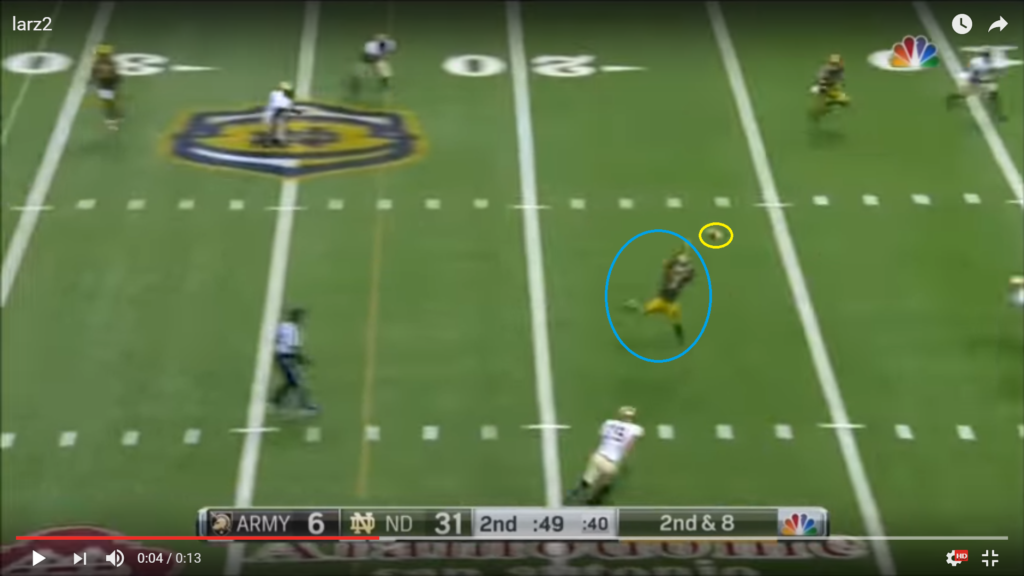
The ball (yellow circle) is in the process of sailing over the receiver’s outstretched arms (blue circle). What should have been an easy completion nearly became an ugly interception.
Final Thoughts
The first problem was that Kizer hesitated. He had a wide open receiver, no pressure, and a perfect throwing lane; there was no reason to hesitate. But he didn’t throw with anticipation, he waited. When he realized he was late he tried to rush the throw and this caused problems.
How did this lead specifically to an overthrow? Any change to normal throwing mechanics has the potential to impact when the quarterback releases the ball. When the ball is released impacts the way the it travels through the air. Generally speaking if the ball is released too early it tends to result in an overthrow, if the ball is released too late, it tends to result in an underthrow. In this example, Kizer lowered the ball before he started the throwing motion, his shoulders rotated too quickly and he was late shifting his weight forward. By themselves, any one of these changes to normal throwing motion has the potential to impact the release point and cause the quarterback to overthrow the receiver. With three problems present, the chances of an inaccurate throw greatly increase.
Inconsistent accuracy will be an on-going problem for Kizer. At times he hesitates and then tries to rush the throw, which creates issues. Even when he doesn’t hesitate he tends to put too much weight on his back foot. His wide throwing stance exacerbates this problem by making it more difficult to get his weight forward. As well, he has a long throwing motion. The longer the throwing motion is, the more opportunities there are to make little mistakes, which can lead to inaccurate throws.
Developing rock solid throwing mechanics takes a really long time. Although he has been inconsistent at times, DeShone Kizer is still a very good quarterback. Hopefully he stays at Notre Dame for another year so he can continue to improve his consistency.

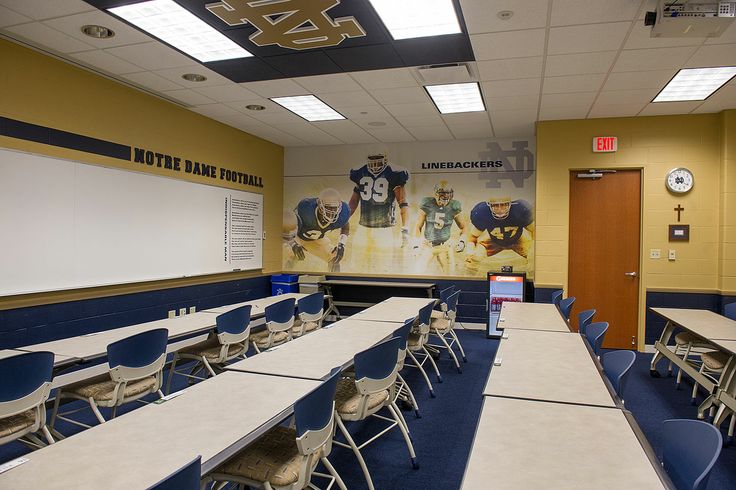


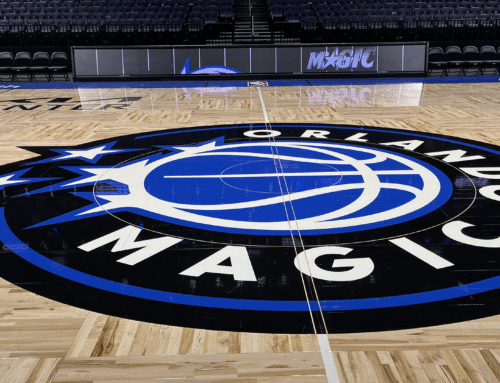
Fire Sanford
Tough but fair
Perhaps last year’s message board discussion of “Maybe Sanford will follow Kelly as head coach” was a bit premature.
I don’t think there is any chance Kizer sticks around. With the QB situation in the NFL, he’s going in the 1st round and he can work on his mechanics while making $$$$.
Yeah, I have a horrible history of predicting who will go to the NFL. My own bias is that if you still need to develop, then you should stay in college. The NFL really isn’t a developmental league, they are too impatient, especially if you are a first rounder. I think Kizer would benefit immensely from another year in college. But I totally agree with your point. If he is going to be drafted high and paid millions of dollars, why would t he go?
Great stuff as always.
That said, given the lack of development so far (really for any ND QB, it seems), would he really improve his mechanics with another year? Also, given how much he has regressed this year, could his poor mechanics be in part due to compensating for some injury preventing “normal” throwing technique? If he’s having pain going through the normal motion, I can see why he might try to rush through the painful part of the throw.
Has Deshone really regressed? I mean, granted, the wins aren’t there this year, but Kizer threw plenty of balls into the dirt last year and had a couple of overthrows — I’d argue he’s had similar numbers of “off” throws each year, just more in the turf in ’15 and more overthrows in ’16. Personally, I kind of think Will Fuller smoothed over some of Kizer’s deficiencies last year with his incredible deep ball tracking and speed, and we’re just seeing “the real Deshone” now.
Also, does it make sense that his mechanics would break down a bit mid-season with more practice time spent on game prep and less on fundamentals?
Great points. I’d love to see someone break down his mechanics last year vs. this year. Or even this point of the season vs. the first game. It’s just frustrating to see well-designed plays fall apart so utterly due to execution.
thanks idocd!
You raise some good points. In terms of Kizer being injured, it’s certainly possible, I assume pretty much everyone is injured to some degree at this point in the season and Kizer has run the ball a lot this year, which increases the chances of an injury. However, injury doesn’t explain the hesitation on this play and if he is so injured that he can’t complete this pass, he shouldn’t be playing. I think these issues with his throwing mechanics have been present for a long time. IIRC, when he was recruited he threw for the staff and did poorly and actually asked for another shot to throw for them, then in spring of 2015 he was brutal, to the point of questioning if he should continue to play. Last year after he became the starter he was inconsistent at times as well (but had a lot of talent around him). So this inconsistency has been there for a while.
I do want to say I think he is a good QB and he has improved. His throwing motion is better than it was last year, he just still needs some work. So yes, I think he could continue to improve if he came back, but I understand that if they NFL wants to pay him buckets full of money, he needs to go. Kizer moves really well in the pocket and when he’s on with his mechanics he is very good. I think the hesitation we see is from playing with young receivers who don’t always do what they are supposed to do and being on a bad team. If Kizer makes a major mistake, it almost certainly means the team will lose. That makes you gun shy after a while.
While I don’t think Kizer has necessarily regressed, I think you raise a good point. BK has struggled to develop QB’s. It really has become an alarming pattern. Hopefully Kizer comes back and has a great year.
I think that’s a good point about the young receivers. It’s natural for us as fans to see a missed throw and assume it’s the QB not putting the ball where he should, but sometimes he’s putting it in the right spot and the WR isn’t running the right route (or breaking it off/adjusting as he should). Not so much a thing that excuses balls in the dirt, but on timing routes it could certainly make it look like the QB is off, when really it’s the WR.
I feel like we’re watching a similar phenomenon to Golson cratering in 2014. Kizer started out looking fantastic, but became less decisive and sloppier with his fundamentals around the same time that we realized BVG’s defense couldn’t stop anyone or anything. The pressure is all on the quarterback, who needs to play perfectly in order for the team to have a shot at winning. That’s also the aspect of Kelly’s offense that I hate the most, the reliance on the qb to seemingly do everything, which has already washed out two promising players during his time at ND.
We are in agreement.
I was told this was the room for an argument…
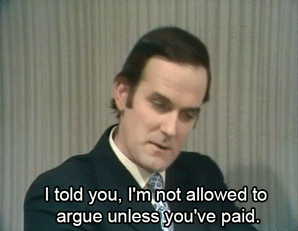
This is a great breakdown. One of my biggest frustrations with Kizer this year has been a tendency to hold onto the ball too long at times, which has resulted in some unnecessary drive-killing sacks. Against a weak pass rush, he still holds onto the ball too long but then the mental clock goes off and the result is a rushed throw.
Poise and confidence in the pocket are both obvious pluses for a QB, but indecision can be just a much a problem as a quick trigger.
Thanks Matt!
Yeah the indecision is a little perplexing. As I said above, I think it is mainly the result of working with inexperienced receivers and playing on a bad team where if you make a major mistake as the QB your team is probably going to lose
Great stuff as usual, Larz. I have many of the same issues with my tennis toss.
is it true Canada is building a wall?
Oops, I mean tennis serve.
Thanks Kiwi!
the wall is on its way up as we speak 🙂
Current construction pictured:
Exactly KG